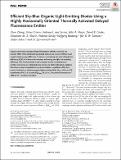Files in this item
Efficient sky-blue organic light-emitting diodes using a highly horizontally oriented thermally activated delayed fluorescence emitter
Item metadata
| dc.contributor.author | Zhang, Zhen | |
| dc.contributor.author | Crovini, Ettore | |
| dc.contributor.author | dos Santos, Paloma Lays | |
| dc.contributor.author | Naqvi, Bilal A. | |
| dc.contributor.author | Cordes, David Bradford | |
| dc.contributor.author | Slawin, Alexandra Martha Zoya | |
| dc.contributor.author | Sahay, Prakhar | |
| dc.contributor.author | Brütting, Wolfgang | |
| dc.contributor.author | Samuel, Ifor David William | |
| dc.contributor.author | Bräse, Stefan | |
| dc.contributor.author | Zysman-Colman, Eli | |
| dc.date.accessioned | 2020-10-23T09:30:04Z | |
| dc.date.available | 2020-10-23T09:30:04Z | |
| dc.date.issued | 2020-12-03 | |
| dc.identifier | 270554718 | |
| dc.identifier | 0af07c55-942c-4057-a397-4e1a79d901d1 | |
| dc.identifier | 85093525943 | |
| dc.identifier | 000582290700001 | |
| dc.identifier.citation | Zhang , Z , Crovini , E , dos Santos , P L , Naqvi , B A , Cordes , D B , Slawin , A M Z , Sahay , P , Brütting , W , Samuel , I D W , Bräse , S & Zysman-Colman , E 2020 , ' Efficient sky-blue organic light-emitting diodes using a highly horizontally oriented thermally activated delayed fluorescence emitter ' , Advanced Optical Materials , vol. 8 , no. 23 , 2001354 . https://doi.org/10.1002/adom.202001354 | en |
| dc.identifier.issn | 2195-1071 | |
| dc.identifier.other | ORCID: /0000-0002-9527-6418/work/82500883 | |
| dc.identifier.other | ORCID: /0000-0002-5366-9168/work/82500895 | |
| dc.identifier.other | ORCID: /0000-0001-7183-6022/work/82501018 | |
| dc.identifier.uri | https://hdl.handle.net/10023/20813 | |
| dc.description | Funding: Deutsche Forschungsgemeinschaft (Grant Number(s): SFB1176), Engineering and Physical Sciences Research Council (Grant Number(s): EP/P010482/1), China Scholarship Council (Grant Number(s): 201606890009), H2020 Marie Skłodowska-Curie Actions (Grant Number(s): 812872). | en |
| dc.description.abstract | Organic thermally activated delayed fluorescent (TADF) materials can harvest 100% of the electrically generated excitons as a result of their small singlet-triplet energy difference. However, maximizing the External Quantum Efficiency (EQE) of a device also requires enhancing the light-outcoupling efficiency. In this work, we present a new Acceptor-Donor-Acceptor (ADA) emitter employing an indolocarbazole donor and diphenyltriazine acceptors that shows nearly-completely horizontal orientation regardless of the host matrix, leading to a sky-blue OLED (λEL=483nm, CIE coordinates of 0.17, 0.32) with EQEMAX of 22.1%, a maximum luminance of 7800 cd/m2 and blue emission. | |
| dc.format.extent | 8 | |
| dc.format.extent | 1424398 | |
| dc.language.iso | eng | |
| dc.relation.ispartof | Advanced Optical Materials | en |
| dc.subject | TADF emitters | en |
| dc.subject | Horizontal orientation | en |
| dc.subject | Outcoupling effect | en |
| dc.subject | Indolocarbazole | en |
| dc.subject | Triazine | en |
| dc.subject | Acceptor-donor-acceptor | en |
| dc.subject | Blue emitters | en |
| dc.subject | OLEDs | en |
| dc.subject | QC Physics | en |
| dc.subject | QD Chemistry | en |
| dc.subject | TK Electrical engineering. Electronics Nuclear engineering | en |
| dc.subject | DAS | en |
| dc.subject.lcc | QC | en |
| dc.subject.lcc | QD | en |
| dc.subject.lcc | TK | en |
| dc.title | Efficient sky-blue organic light-emitting diodes using a highly horizontally oriented thermally activated delayed fluorescence emitter | en |
| dc.type | Journal article | en |
| dc.contributor.sponsor | EPSRC | en |
| dc.contributor.sponsor | EPSRC | en |
| dc.contributor.sponsor | European Commission | en |
| dc.contributor.institution | University of St Andrews. School of Chemistry | en |
| dc.contributor.institution | University of St Andrews. EaSTCHEM | en |
| dc.contributor.institution | University of St Andrews. Centre for Biophotonics | en |
| dc.contributor.institution | University of St Andrews. Condensed Matter Physics | en |
| dc.contributor.institution | University of St Andrews. School of Physics and Astronomy | en |
| dc.identifier.doi | https://doi.org/10.1002/adom.202001354 | |
| dc.description.status | Peer reviewed | en |
| dc.identifier.grantnumber | EP/P010482/1 | en |
| dc.identifier.grantnumber | EP/P010482/1 | en |
| dc.identifier.grantnumber | 812872 | en |
This item appears in the following Collection(s)
Items in the St Andrews Research Repository are protected by copyright, with all rights reserved, unless otherwise indicated.

